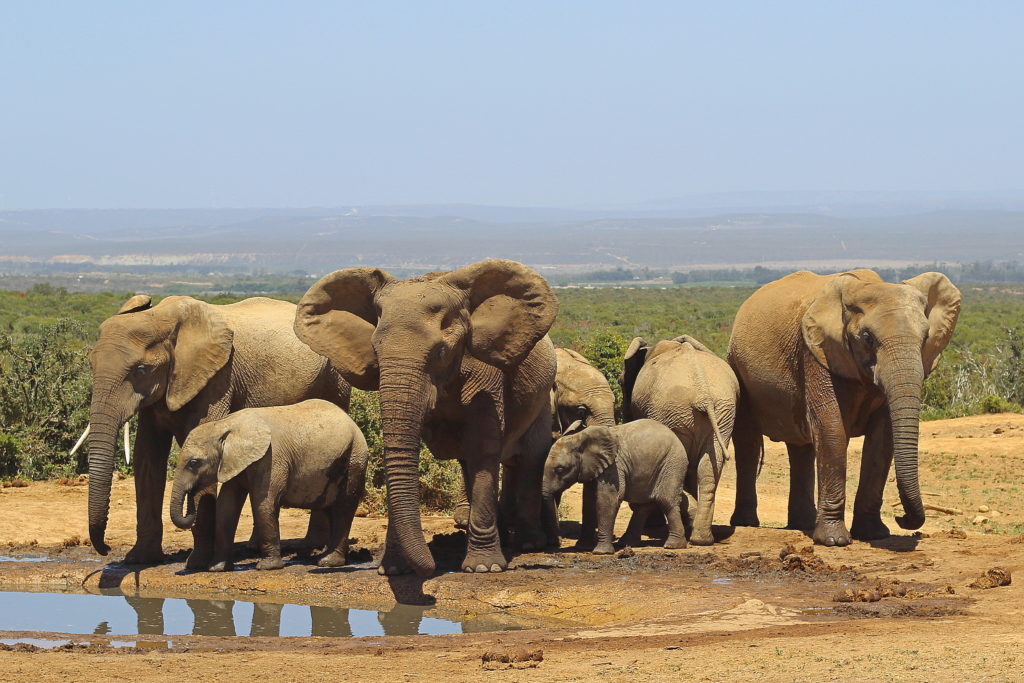By Steven Lang
As an enjoyable and fascinating excursion, there is probably no better value than a visit to the Addo Elephant Park. It is exciting in its unpredictability, as you never know what is around the next bush, and absorbing as you watch animals interact with each other in diverse environments.
The Matyholweni Entrance near Colchester is 91km from Makhanda, so it takes about an hour to get there. The gates are open from 7am to 6.30pm and normally it takes about 10 minutes to wait in line and fill out a form. In the peak holiday season, an increase in the number of visitors means you could wait for up to an hour.
SANParks could reduce these annoying delays by adding more staff at reception during peak season and making the forms available online.
As its name would imply, the Addo Elephant Park is one of the best places in the world to take photos of elephants. I have taken literally thousands of pictures of elephants swimming in the brown mud at Hapoor Dam; snorkelling in the reddish black waters of Gwarrie Dam and pushing buffaloes out of the way at the Ngulube water hole.
Last week, about 15 elephants were hogging (there were also several warthogs) the small waterhole in front of the Spekboom Hide. A lone zebra stood by patiently waiting in vain for his turn to drink. The elephants drank their fill, splashed themselves and wallowed leisurely in the mud. Still, the zebra waited in the baking sun, motionless.
The huge matriarchs used their trunks to give themselves showers while they watched their 200kg babies prancing in the cool muddy water. They were having such fun.
When the zebra could stand it no longer, he suddenly blasted out a loud, braying whinny of frustration. The herd of startled elephants leapt into action positions ready to face the enemy. The unexpected reaction of the elephants terrified the zebra so that he galloped off as fast as he could into the distance.
In one day, I estimate conservatively that I saw more than 300 elephants, many of them less than five metres from my car. An official census of elephant numbers has not been published for a few years, but the last count revealed that there were more than 600 in the park. I believe that the figure has now increased to over 700.
Some of the areas around the water holes have been so trampled on that the park management decided to enclose them inside electrified fences suspended from wires strung between tall posts. The fences are open up to a height of 1.6m so that other animals can come and go as they please, but the elephants will touch the low powered wires, receive a shock and avoid the area. The problem is that now some of the elephants have learned to duck under the wire and the terrain around the water holes resembles a moonscape.
The elephant population at Addo is dense, but they seem to be less aggressive than those at other parks. They are used to dozens of cars at the observation parking lot right next to Hapoor Dam, where they often walk between cars and sometimes even gently touch them.
Most visitors want to know whether they can see the ‘Big Five’ at Addo and they are pleasantly surprised to find out that the park boasts of the ‘Big Seven’: lion, leopard, buffalo, elephant, rhino, the southern right whale and the great white shark.
While this boast is technically true, it is not realistic to expect to see all seven animals in one visit because Addo is made up of several sections that are not directly open to each other. If you visit the main section, you stand an excellent chance of seeing elephants and buffaloes, as well as a fair chance of seeing some of the seven lions.
Over the past decade, I have been to Addo about 30 times but I have never seen a rhino in the park even though some people have assured me that they are there. If you do see a rhino, conservation management has asked visitors not to post pictures of these animals on social media.
Leopards have not been seen in the main section of the park since anyone can remember, but a guest recently posted on WhatsApp a picture of a leopard in the Nyathi Section.
The remaining two members of the elite ‘Big Seven’ can only be seen form the coastal section of the Addo Park.
Practical Tips
When you decide to visit the Addo Park, it a good idea to plan your bathroom breaks. Only three places in the main section have toilets: Matyholweni Gate, Jack’s Picnic Place and the Main Rest Camp.
Take your own food. It’s much nicer to sit at a dam watching wildlife while eating your sandwiches than spending a lot of money at the Main Camp restaurant. Only the Main Camp has a petrol filling station, a general store and a restaurant. Expect to take at least two hours to travel from one end of the park to the other.


